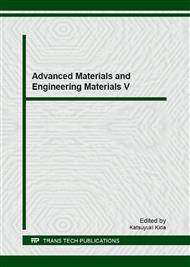p.331
p.337
p.345
p.349
p.354
p.360
p.365
p.371
p.376
Effect of Nano-CaCO3/Limestone Powder Composite on the Early Age Cement Hydration Products
Abstract:
In this study, the effect of surface structure of nanoCaCO3/limestone powder composite particles (NC/LS) on the hydration products of cement at early age is investigated. The surface structure of NC/LS is observed by field emission scanning electron microscope (FE-SEM) and compared with original limestone powders. X-ray diffraction (XRD) is used to investigate the types of hydration products and calculate the Ca (OH)2 (CH) particle size and crystal orientation degree. Additionally, FE-SEM and atomic force microscopy (AFM) are applied to observe the particle size, shape and distribution of hydration products. The results reveal that the nanoCaCO3 particles are distributed throughout the surface of limestone powders, and therefore successfully formed NC/LS. Secondly, the particle size, morphology and distribution of the cement hydration products are affected by the surface structure of NC/LS, so the microstructure of hardened cement paste at early age is enhanced.
Info:
Periodical:
Pages:
354-359
Citation:
Online since:
August 2016
Authors:
Keywords:
Price:
Сopyright:
© 2016 Trans Tech Publications Ltd. All Rights Reserved
Share:
Citation:


